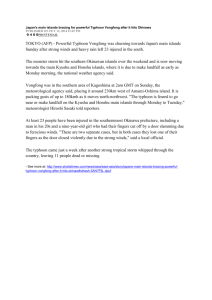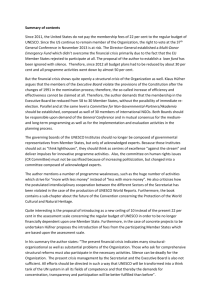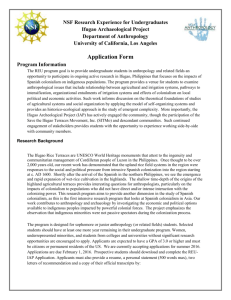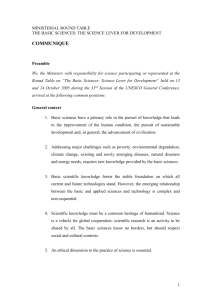Philippines-Ifugao chant as UNESCO Masterpiece
advertisement
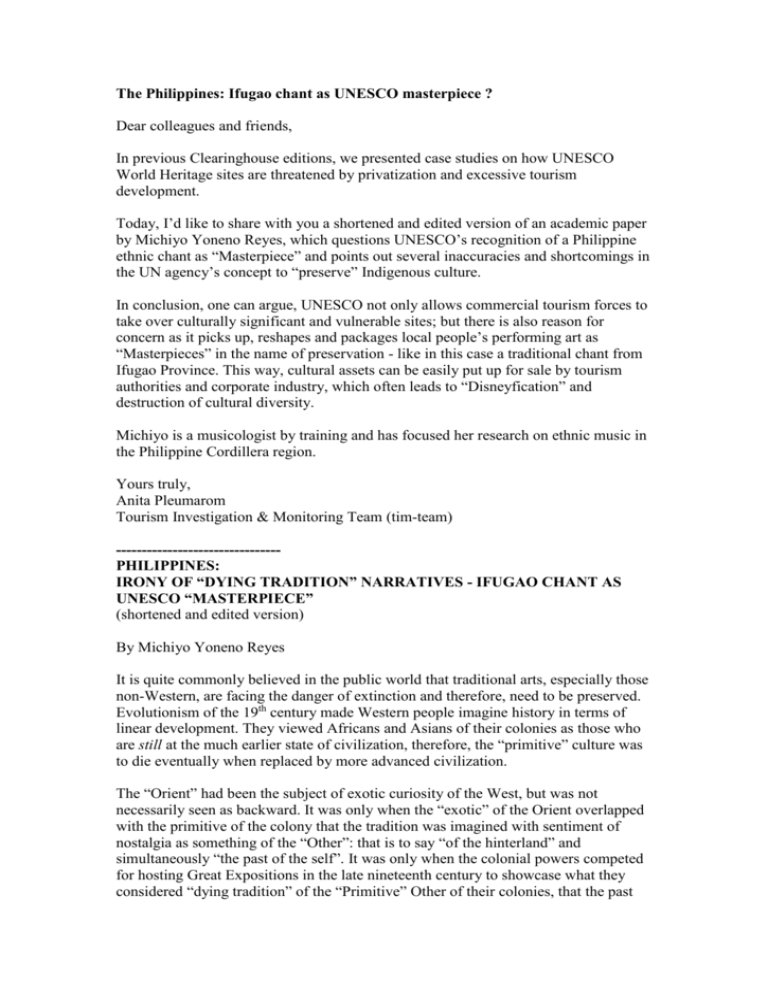
The Philippines: Ifugao chant as UNESCO masterpiece ? Dear colleagues and friends, In previous Clearinghouse editions, we presented case studies on how UNESCO World Heritage sites are threatened by privatization and excessive tourism development. Today, I’d like to share with you a shortened and edited version of an academic paper by Michiyo Yoneno Reyes, which questions UNESCO’s recognition of a Philippine ethnic chant as “Masterpiece” and points out several inaccuracies and shortcomings in the UN agency’s concept to “preserve” Indigenous culture. In conclusion, one can argue, UNESCO not only allows commercial tourism forces to take over culturally significant and vulnerable sites; but there is also reason for concern as it picks up, reshapes and packages local people’s performing art as “Masterpieces” in the name of preservation - like in this case a traditional chant from Ifugao Province. This way, cultural assets can be easily put up for sale by tourism authorities and corporate industry, which often leads to “Disneyfication” and destruction of cultural diversity. Michiyo is a musicologist by training and has focused her research on ethnic music in the Philippine Cordillera region. Yours truly, Anita Pleumarom Tourism Investigation & Monitoring Team (tim-team) -------------------------------PHILIPPINES: IRONY OF “DYING TRADITION” NARRATIVES - IFUGAO CHANT AS UNESCO “MASTERPIECE” (shortened and edited version) By Michiyo Yoneno Reyes It is quite commonly believed in the public world that traditional arts, especially those non-Western, are facing the danger of extinction and therefore, need to be preserved. Evolutionism of the 19th century made Western people imagine history in terms of linear development. They viewed Africans and Asians of their colonies as those who are still at the much earlier state of civilization, therefore, the “primitive” culture was to die eventually when replaced by more advanced civilization. The “Orient” had been the subject of exotic curiosity of the West, but was not necessarily seen as backward. It was only when the “exotic” of the Orient overlapped with the primitive of the colony that the tradition was imagined with sentiment of nostalgia as something of the “Other”: that is to say “of the hinterland” and simultaneously “the past of the self”. It was only when the colonial powers competed for hosting Great Expositions in the late nineteenth century to showcase what they considered “dying tradition” of the “Primitive” Other of their colonies, that the past became objectified as valuable to be viewed. The tangible artifacts became museumnized and intangible performing arts became stagenized. Under the post-colonial context, the so-called “New Nations” in general deal with the issue of “preservation of the tradition” as State projects. The irony is that the young nations adapt the mode of preservation and presentation of arts, the very product of the Imperialism in their struggle for their own national culture building. In 2001, the UNESCO proclaimed the “hudhud”, a narrative chant from Ifugao Province of Northern Philippines as one of the Masterpieces of the Oral and Intangible Heritage of Humanity. Simultaneously, an Action Plan was announced and the national and local governments of the Philippines are expected to implement the projects and programs for the preservation of the “hudhud”. This paper reviews these preservation projects/programs and intends to evoke broader, critical discussion on cultural policy. My two major concerns here are: a) the vagueness of concept of “preservation” of performing arts and, b) the absence of the voice of the people from Ifugao Province in decision-making. Indigenous chants in the Cordillera Region and the meaning of “hudhud” Many ethnographic accounts on “hudhud” describe it as “narrative chant about mythical heroes of the Ifugaos, performed during death vigil of prominent person as well as harvest ritual”. Among a number of chants performed by different peoples in the Cordillera, the “hudhud” is one of the most studied. I consider this fact as merely incidental, yet it appears to be the crucial factor for its recognition by UNESCO. Therefore, to me it is not very convincing why only “hudhud” should gain special treatment, either positive or negative, despite that there are many types of similar and dissimilar chants practiced in the different areas in the country. Between the 1920s and 1980s, a Belgian priest, Fr. Francis Lambrecht, made a series of extensive studies on “hudhud” throughout six decades, which brought “hudhud” into the international notice. Meanwhile, Amador T. Daguio, a member of the textbook committee of the Bureau of Public Schools of the Philippines, submitted a MA thesis in Literature “Hudhud hi Aliguyon: A Translation of an Ifugao Harvest Song with Introduction and Notes” to Stanford University (Amador 1953). It is the first comprehensive translation of “hudhud” narrative into an other language (English). This study indicates the Philippine government’s interests in the “ethnic” materials in education in early years of independence. It was only since the late 1960s that local scholars began to conduct anthropological studies in the Philippines. Lowland/urban Filipino researchers sallied out into the “exotic” communities of so-called “cultural minorities” in remote areas. The anticolonial mood of the time inevitably bestowed them the desire of searching for the “original” culture of the Philippines. Yet, ironically enough they were highly oriented by the well-versed works of foreign missionaries of previous generation, and conditioned greatly by American’s view on the archipelago that dichotomizes the highland and lowland, assuming that the original culture of the Philippines exists among non-Christians communities in remote areas. This assumption served as the basic thesis for different “nationalism” ideologies: from the new-Marxist anticolonialism to President Marcos’ dictatorship with slogan “Isang bansa, isang lahi, isang tahana” (One nation, one people, one destiny). It was in this social milieu that Jose Maceda demonstrated his strong leadership in collecting and recording various “Philippine musics” nationwide. Though not very systematically, various forms of music, both vocal and instrumental, from different peoples and places have been known to scholars. Chants of the Cordillera alone include “ullalim”, “adding”, “dango” (Kalinga), liwliwa (Mountain Province), “liwliwa”, “hudhud” and “alim” (Ifugao), “oggayam” (Kalinga, Mountain Province etc.) among others. As for “hudhud”, “Mga Ilang Tala Ukol sa Musika ng mga Ifugao” and “Notes on Ifugao Oral Literature” both by Rosario Lorrin are examples of the product of the series of researches conducted in this period. The seemingly significance of “hudhud” has been established through quotations of studies, or though merely largeness of quantity of written studies, ignoring many other various types of chants of the Cordillera , both similar and dissimilar ones, of probably equal significance. UNESCO’s recognition of Ifugao “hudhud” chant UNESCO’s recognition of a certain site as World Heritage marks considerable impact on its host community, especially in remote areas of developing countries where economic and political power is much weaker than that of leading countries. The World Heritage site usually becomes a tourist spot and it is next to impossible to prevent any outside impact. As a result, while protective projects/programs are being implemented, it often faces, paradoxically, the unexpected physical and/or circumstantial damages. Tourism alone is a highly contested field. It is probably the overlooked reality among the so-called culture and art specialists of the developed countries that in many developing countries tourism is one of the most crucial means of gaining foreign currency desperately needed for economic development. It is far from being a mere sacred zone of nostalgia where the past is romantically imagined and reconstructed like in the economically advanced countries. The following is my critical review of UNESCO’s official statement on “hudhud” as Masterpiece of Intangible Heritage. The overall tone of the statement is unscholarly in a sense that each accounts lack accuracy and is full of romantic assumption that “all tradition is dying because of modernization”. Such presumption, which may be more touching to common readers though, ignores the complex dynamics of cultural change that challenges anthropologists and ethnomusicologists. First, the UNESCO defines the “hudhud” as follows: “the hudhud is recited and chanted among the Ifugao people – known for their rice terraces – during the sowing and harvesting of rice, funeral wakes and other rituals. Estimated to have originated before the 7th century, the “hudhud” – comprised of some 40 episodes – often take three or four days to recite. The language of the chants, almost impossible to transcribe, is full of repetitions, synonyms, figurative terms and metaphors. Performed in a leader/chorus style, the reciter - often an elderly woman – occupies a key position in society. There is only one tune, common to the entire region, for all of the verses. Very few written examples of hudhud exist” (UNESCO website). First of all, the generalization of “hudhud” as a practice of the Ifugao people goes against the way people of Ifugao Province may look at it. The “hudhud” is not observed in the entire Province of Ifugao. It is most popular in the area around Kiangan municipality, merely one of the 11 municipalities in Ifugao Province. Hindered by steep geographical features, even in Ifugao Province alone with an approximate population of 150,000, several ethno-linguistic groups live side by side without much mingling, rather with tension to each other. Considering the internal diversity within Ifugao Province – including the diversity of cultural features such as narrative chants -, on which the local population is highly alert, announcing “hudhud” as heritage of the Ifugao is probably not agreeable to the residents of Ifugao Province at large. Secondly, dating the origin of “hudhud” before the 7th century, is questionable since the historical-anthropological studies in the Philippines have not developed enough to determine the period of events of the pre-Hispanic period in the Cordillera Region, which Ifugao Province is a part of. Some experts assume the development of wet rice cultivation gave birth to “hudhud”, which could have been between 18th century and 19th century. Meanwhile, the famous rice terraces of Banawe are believed to be thousand years old through popular narratives. Thirdly, UNESCO’s statement “the reciter – often an elderly woman – occupies a key position in society” does not capture the reality accurately. The complexity of power relations in the local community should be examined more sensitively. The “hudhud” singer may do receive a certain respect in the community. But there exist other bodies that likewise carry the power in various senses in different contexts. Even in a “traditional” context, powerful are the ritual conductor (Mumbaki etc.), and persons with large scale of property (kadangyan etc.), among others. Historically speaking, in some areas in Ifugao such as Kiangan, colonial powers have been strong. Moreover, in the contemporary context, gaining local influence are the local government offices and officials, NGOs and Peoples Organizations, Christian churches, educated individuals, etc. The UNESCO then enumerates the “threats” against the “hudhud” as justification for proposing “preservation” programs: “The conversion of the Ifugaos to Catholicism weakened their traditional culture. The “hudhud” was linked to the manual harvesting of rice, which is now mechanized. It has been replaced at general wakes by television and radio. Although the rice terraces are inscribed on the World Heritage list, the number of cultivators continues to decrease. The few people who know all the poems are very old and young people re not interested in this tradition.” The threats depicted here are vague and inaccurate. First of all, the Catholicism is not always harmful against native tradition. Although it is true that the tendency to drive away traditional rituals in favor of Christian doctrine is more often observed in Ifugao Province than in other Provinces of the Cordillera Region on one hand. On the other hand, the so-called “inculturation” movement of the Roman Catholic Church has inspired and contributed to the revival of the tradition. The statement “(the hudhud) has been replaced at funeral wakes by television and radio” also needs to be verified. Based on my observation, this may be true but merely to a very limited extent. Although modern technology is gradually penetrating some advanced towns in Ifugao, many villages do without or with very little supply of electricity. Consequently the extent of its influence varies from one village to another even within Kiangan municipality. As for the decrease of the number of rice terrace cultivators, a more profound analysis is needed to determine its causes. Listing the Banawe (not of Kiangan, but another town in Ifugao Province) rice terraces as World Heritage does not necessarily bring a solution to save them. Rather, ironically, the promotion of tourism has brought massive entry of the monetary economy and increased the financial pressure on peasants and the need for peasants to neglect the rice terraces. At any rate, however, the UNESCO World Heritage site - the Banawe Rice terraces does not cover the rice terraces of Kiangan. The Ifugao Province as political unit is merely incidental to the local population. Banawe and Kiangan are not identical as each town strongly follows its own practices. It is therefore incoherent referring to Banawe terraces in relation to “hudhud” in terms of causes of “dying tradition”. Finally, follows UNESCO’s proposed Action Plan for preservation of the “hudhud”: “The rights of indigenous peoples are protected by Philippine law, including their intellectual property. Publication of historical and ethnological iconographs is planned. The government also proposes festivals and indigenous ceremonies. The National Library and National Museum are responsible for a complete archive of the hudhud. A project teaching the tradition to young people is foreseen.” The first sentence apparently refers to the Indigenous Peoples Rights Act (IPRA) of 1997. The law recognizes the Indigenous Cultural Communities (ICCs) and Indigenous Peoples (IPs) “rights to use and control of ceremonial objects” and “full ownership and control and protection of their cultural and intellectual rights” in its Chapter IV for Cultural Integrity. Simultaneously, the State’s role is limited to “respect, recognize and protect the right of ICCs/IPs to preserve and protect their culture, traditions and institutions” and to prove “with the financial and technical support of the national government agencies”. The UNESCO’s statement is self-contradicting because it mentions the rights of the Indigenous Peoples by implying IPRA on the one hand, but on the other hand it supports the State’s initiative in documentation through the National Museum and National Library. The IPRA must be interpreted in terms of the initiatives of ICCs/IPs. The role of the State must be supplementary, never decision-making. It is not legitimate that the State imposes plans onto ICCs/IPs. All the following plans – iconography, festivals, indigenous ceremonies (odd term!), and archive – need to be carefully examined. Those modes of representation were introduced to Asia under colonial framework, and continue to reflect asymmetrical relations of power between the action and the object: in this case the State (National Museums/National Library) and the “hudhud” and its performers. Under this scheme, the object is made to provide the most ideal picture to satisfy the expectation of the decision-maker. The principal question here is “who represents whom/what for whom?” In this relation, the failure of two “festival” projects in the past in the Cordillera is worth mentioning: The Grand Canao Festival and Besao Arts Festival. The “canao” is a term for communal wedding feast hosted by and celebrated for rich families among the Ibaloi communities, another highland ethno-linguistic group in the Cordillera Region. In 1979-1983, the Department of Tourism proposed the annual Grand Canao Festival in Baguio City, home of the Ibalois, as a tourism attraction. However, the event was strongly booed by the Ibalois as “fake ritual”. It was abolished after a few years, and later in 1990 it was even associated with the advent of a big earthquake that hit the city. Similarly, the First Besao Festival, in Mountain Province, as project of the National Commission on Culture and Arts (NCCA), miserably failed to gain local support. It was held in October in 1996 in Besao, Mountain Province, another highland community in the Cordillera. The venue was changed from its originally planned town due to the strong resistance from the community. Finally convinced by the agents, the elders of Besao agreed to conduct the “begnas” (agricultural rite) for the sake of ”festival” as a show for only a few members of the NCCA who arrived from Metro Manila to videotape and photograph it. The even was exposed to criticism from within and outside the community. Also, a tragic jeepney accident, which took place after two months, was attributed to the festival that was removed from the traditional cultural context. No Second Festival has followed. Even the NCCA admits the questions and doubts expressed by the host community, citing a baranggay (village) captain saying “we don’t want our culture to be sold to tourism.” Most probably one of the primary reasons of the rejection of the local community is that both “canao” and “begnas” are rituals that are very alive. Being so, the commoners of the communities would find sacredness in them and fear of inappropriate conduct of them, as practitioner of tradition and of animism. Furthermore, the local population would not find the reason why those rituals need to be preserved when they are alive. The urban public in the Philippines is misled by the popular narrative, the fictitious world, that the “original Philippine culture lies in the IP communities such as in the Cordillera and it needs to be preserved because it is dying.” It is this narrative, the fictitious world that brings about not only incoherent but even damaging ideas of preservation to remote communities. Nevertheless, the NCCA prepared the application of “hudhud” for the Intangible Heritage. What is common in those three cases is the absence of dialogue with equal relationship between the State and the Indigenous communities in planning and implementing. Any preservation projects/programs would be more successful when the practitioners themselves take initiatives, and most ideally, when the equal power is established between the local community, State and funding agencies. Cultural policies need to be scrutinized UNESCO marks the culmination of the UN decade for culture and development through its report “Our Creative Diversity” (World Commission on Culture and Development:1995). As Susan Wright wrote in Anthropololy Today (1998), “Anthropologists played a major role in formulating the idea of culture which this report proposes should be the basis for world ethics and development policy. Anthropologists of development have long sought such influence”. Consequently, even the World Bank recognizes the importance of cultural sensitivity on development projects as manifested by its Culture & Poverty – Learning-Research Program. It states, “Culture is a whole complex of distinctive spiritual, material, intellectual and emotional features that characterize the society or societal group. It includes creative expression, oral history, language, literature, performing arts, fine arts and crafts, community practice, traditional healing methods, traditional natural resource management, celebrations and patterns of social interaction that contributes to groups and individual welfare and of course, material or built forms such as sites, buildings, historic city centers, landscape, arts and objects.” (Wolfensohn 1999) However, it is - or is it not? - surprising that UNESCO’s definition on culture falls on an old-fashioned manner. It echoes the definition of culture by E. Tylor back to the late nineteenth Century: “‘Culture’ is that complex whole which includes knowledge, belief, art, morals, law, customs and any other capabilities and habits acquired by man (sic) as a member of society.” (Tylor 1871). As globalization brings a new picture of the world, where Nation-State is deteriorating and locality establishes direct links with the globe, the meaning of UNESCO as assembly of Nation-States is changing. Especially when it comes to IP issues, which often hold conflicting interests with national government (and even with local government units as state agent), the deal must be handled with critical sensitivity. As ‘culture’ gains significance in public world, the UNESCO is expected to become indispensable body in culture and arts at large than ever. All participating agents must make efforts to bridge the gap between academic discourse on culture and public notion of it at all levels, from local to global/international. NGOs have significantly contributed to development projects in developing countries in Asia in the past decades. However, this movement is rather limited to basic development projects in a conventional sense such as infrastructure, environment, food security, health, human rights, etc. As for cultural policy, it is so far solely in the hands of the officials. No mechanism to query its legitimacy exists. Asian developing countries are today in need of civil society bodies that can alarm the public of the impact of cultural policies that are overly tourism-centered, state-oriented, and therefore primarily for the benefit of the urban upper-middle class. Globalization gives birth to a new consciousness of diversity. The culture of Indigenous Peoples is an issue to be discussed most enthusiastically and dwelt with most delicately in the 21st century. -------------------------------NOTE: The articles introduced in this Clearinghouse do not necessarily represent the views of the Tourism Investigation & Monitoring Team (tim-team).
